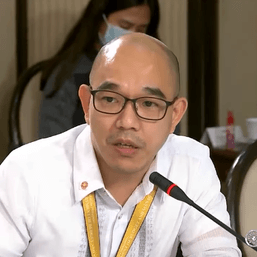SUMMARY
This is AI generated summarization, which may have errors. For context, always refer to the full article.
![[Sui Generis] Prequel to Pharmally’s pandemic corruption](https://www.rappler.com/tachyon/2021/09/frigates-september-22-2021-sq.jpg)
Before Pharmally, there was Hyundai. The circumstances may differ but the basic theme is the same: powerful government officials get involved in multi-billion peso deals to the detriment of the public, leaving a trail of unanswered questions.
In the case of Hyundai Heavy Industries, in 2017, certain officials in Malacañang interfered in a P15.5-billion deal that was supposed to be decided by the Philippine Navy and the Department of National Defense (DND). Malacañang favored a supplier that the Navy had rejected.
Hyundai was to build two frigates for the Navy and it chose Hanwha Systems, also a Korean company, to provide the Computer Management System (CMS). The Navy preferred a tested CMS, that of a Dutch company, Tacticos Thales.
A short note on the CMS: It is a computer system that is considered the heart of warships as it integrates real-time data from the ship’s sensors and other parties or navies to know what’s going on at sea. The supplier of the CMS is not the same as the builder of the warships.
It turned out that the contract signed by the DND had a fine-print provision which said that Hyundai had the right to choose the CMS supplier. This was the contentious part, causing a back-and-forth between the DND and the Navy chief.
While this debate was going on, Malacañang stepped in. In the end, Hyundai got its way, leaving the Navy on the losing end.
This may have been the original sin, as Carmela Fonbuena, then Rappler reporter who broke the story and followed the paper trail, put it to me.
![[Sui Generis] Prequel to Pharmally’s pandemic corruption](https://img.youtube.com/vi/0gp0I7pX1os/sddefault.jpg)
It was a questionable contract that the Senate blue ribbon committee cursorily investigated. The committee, led by Senator Richard “Dick” Gordon, concluded its friendly probe without pursuing key questions, seemingly afraid to offend President Duterte. When Bong Go testified before the Senate, he came with the Duterte Cabinet in full force.
This was in 2018, and many of the senators knew the tide of politics was in favor of the new president. (You can read more about the Senate probe here.)
Chain of events
Let’s go back to what happened.
The dubious actions of Malacañang began in 2017, in the office of Special Assistant to the President Christopher “Bong” Go.
- January 12, 2017 – While in Malacañang, Defense Secretary Delfin Lorenzana receives a white paper endorsing a supplier for the CMS for the two warships ordered by the Navy from Hyundai. (This is the supplier, Hanwha Systems, that the Navy thumbed down.) Lorenzana tacks a Post-It note saying it came from Bong Go and sends the white paper to Navy chief Vice Admiral Ronald Mercado, instructing him to rebut it.
- January 18, 2017 – Undersecretary Christopher Lao (a most familiar name today), who works at Go’s office, writes the Navy officer in charge of the frigates project, Commodore Robert Empedrad, to invite him to a January 20 meeting in Malacañang to discuss the CMS selection.
- January 20, 2017 – The meeting in Malacañang takes place but details on attendance and what is achieved are not known.
- January 23, 2017 – Empedrad submits a written report to Malacañang explaining the selection of the CMS. It is addressed to Duterte and Go.
- March to November 2017 – In various exchanges with DND, Mercado staunchly defends the Navy’s preference for the proven technology, the CMS of a Dutch company, Tacticos Thales, which is used by 23 countries in over 172 ships.
- December 19, 2017 – Mercado is taken out as Philippine Navy chief – unprecedented in the Navy’s history – because of supposed “insubordination” over the frigates project.
- January 17, 2018 – After Rappler and the Inquirer report Go’s “intervention” in the frigates deal, Lorenzana says he no longer remembers if it was Go who gave him the white paper.
- January 18, 2018 – Empedrad succeeds Mercado as Navy chief. He initially favored Tacticos Thales but changed his tune.
- February 19, 2018 – In a hearing, some senators, including Gordon, vouch for Go’s innocence.
- February 20, 2018 – Duterte orders the Presidential Security Group to ban Rappler’s Malacañang reporter, Pia Ranada, from entering the Palace. The President issued the order apparently after watching the Senate hearing, which mentioned Rappler’s stories on the frigates scandal.
- October 19, 2018 – In a speech, Duterte admits that he acted on the complaint of the South Korean firm – the white paper was from Hanwha Systems – handing it to Go so that the latter could refer it to the Malacañang lawyers.
Powerful warships
Fast forward to May 2020. The first of the two Korean-made frigates, the BRP Jose Rizal, the Philippine Navy’s first missile-ready warship, arrived in Subic, Zambales, and is said to be “the most powerful and lethal of the Navy’s warships.”
Worth P8 billion, it is capable of anti-air, anti-surface, anti-submarine, and electronic warfare.
This was followed by the arrival of the second brand-new missile-capable frigate, christened BRP Antonio Luna, in February 2021.
Still, we’re left with questions to ponder: Why did the Korean firm, Hanwha Systems, complain to Malacañang? How did they find a connection to Go? Why was Mercado ousted? Why did the President, Go, and Lao get involved in an issue that should have been resolved by the DND?
What if the Senate rigorously looked into the P15.5-billion frigates deal – the way they are dissecting the Pharmally scandal today? Would Go and Lao have been stopped in their tracks? Would Pharmally have been avoided?
But, as we know, history is full of what ifs. – Rappler.com
Add a comment
How does this make you feel?



![[WATCH] Bamban POGO scandal: There’s a bigger fish than Alice Guo](https://www.rappler.com/tachyon/2024/07/inside-track-tcard-bamban-pogo.jpg?resize=257%2C257&crop=435px%2C0px%2C1080px%2C1080px)
![[Vantage Point] China’s silent invasion of the Philippines](https://www.rappler.com/tachyon/2024/07/TL-china-silent-invasion-july-16-2024.jpg?resize=257%2C257&crop=318px%2C0px%2C720px%2C720px)









There are no comments yet. Add your comment to start the conversation.